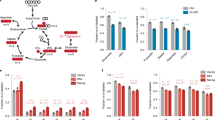Abstract
Mouse embryonic stem cells (mESCs) can be captured in vitro in different pluripotency states through media modulation, mimicking their natural environment during early embryo development. As highly proliferative cells, mESCs prefer to use glycolysis to support the energetic and biosynthetic demands, even in the presence of oxygen. Indeed, glycolysis can not only supply ATP at a much faster rate, when compared to other catabolic pathways, but also provides biosynthetic substrates to meet anabolic requirements. Considering that ESCs cultured in different media conditions display distinct metabolic requirements, it is of utmost importance to have a robust metabolic characterization methodology to understand how subtle metabolic variations may be coupled to ESC identity. Here we describe how to profile the glycolytic activity of naive mouse ESC, using the established Seahorse XFe24 Live-cell Metabolic Assay. This may be a useful protocol for understanding how the glycolytic function of mESCs changes in certain circumstances and how is it coupled to diverse pluripotency/differentiation phenotypes.
Bibiana Correia and Maria Inês Sousa contributed equally and should be considered co-first authors.
Access this chapter
Tax calculation will be finalised at checkout
Purchases are for personal use only
Similar content being viewed by others
References
Nichols J, Smith A (2012) Pluripotency in the embryo and in culture. Cold Spring Harbor Perspect Biol 4(8):1–154. https://doi.org/10.1101/cshperspect.a008128
De Los Angeles A, Ferrari F, Xi R et al (2015) Hallmarks of pluripotency. Nature 525:469–478. https://doi.org/10.1038/nature15515
Weinberger L, Ayyash M, Novershtern N et al (2016) Dynamic stem cell states: naive to primed pluripotency in rodents and humans. Nat Rev Mol Cell Biol 17:155–169. https://doi.org/10.1038/nrm.2015.28
Brons IGM, Smithers LE, Trotter MWB et al (2007) Derivation of pluripotent epiblast stem cells from mammalian embryos. Nature 448:191–195. https://doi.org/10.1038/nature05950
Tesar PJ, Chenoweth JG, Brook FA et al (2007) New cell lines from mouse epiblast share defining features with human embryonic stem cells. Nature 448:196–199. https://doi.org/10.1038/nature05972
Mathieu J, Ruohola-Baker H (2017) Metabolic remodeling during the loss and acquisition of pluripotency. Development 144:541–551. https://doi.org/10.1242/dev.128389
Tsogtbaatar E, Landin C, Minter-Dykhouse K et al (2020) Energy metabolism regulates stem cell pluripotency. Front Cell Dev Biol 8:1–16. https://doi.org/10.3389/fcell.2020.00087
Varum S, Rodrigues AS, Moura MB et al (2011) Energy metabolism in human pluripotent stem cells and their differentiated counterparts. PLoS One 6(6):e20914. https://doi.org/10.1371/journal.pone.0020914
Pereira SL, Rodrigues AS, Sousa MI et al (2014) From gametogenesis and stem cells to cancer: common metabolic themes. Hum Reprod Update 20:924–943. https://doi.org/10.1093/humupd/dmu034
Rodrigues AS, Correia M, Gomes A et al (2015) Dichloroacetate, the pyruvate dehydrogenase complex and the modulation of mESC pluripotency. PLoS One 10:e0131663. https://doi.org/10.1371/journal.pone.0131663
Rodrigues AS, Pereira SL, Correia M et al (2015) Differentiate or die: 3-Bromopyruvate and pluripotency in mouse embryonic stem cells. PLoS One 10:e0135617. https://doi.org/10.1371/journal.pone.0135617
Nelson DL, Cox MM (2017) Lehninger principles of biochemistry, 7th edn. W. H. Freeman and Company All, New York
Roosterman D, Meyerhof W, Cottrell GS (2018) Proton transport chains in glucose metabolism: mind the proton. Front Neurosci 12:1–15. https://doi.org/10.3389/fnins.2018.00404
Sousa MI, Rodrigues AS, Pereira S et al (2015) Mitochondrial mechanisms of metabolic reprogramming in proliferating cells. Curr Med Chem 22:2493–2504. https://doi.org/10.2174/0929867322666150514095718
Folmes CDL, Nelson TJ, Dzeja PP et al (2012) Energy metabolism plasticity enables stemness programs. Ann N Y Acad Sci 1254:82–89. https://doi.org/10.1111/j.1749-6632.2012.06487.x
Zhu S, Li W, Zhou H et al (2010) Reprogramming of human primary somatic cells by OCT4 and chemical compounds. Cell Stem Cell 7:651–655. https://doi.org/10.1016/j.stem.2010.11.015
Folmes CDL, Nelson TJ, Martinez-Fernandez A et al (2011) Somatic oxidative bioenergetics transitions into pluripotency-dependent glycolysis to facilitate nuclear reprogramming. Cell Metab 14:264–271. https://doi.org/10.1016/j.cmet.2011.06.011
Kim H, Jang H, Kim TW et al (2015) Core pluripotency factors directly regulate metabolism in embryonic stem cell to maintain pluripotency. Stem Cells 33:2699–2711. https://doi.org/10.1002/stem.2073
Yu L, Ji K, Zhang J et al (2019) Core pluripotency factors promote glycolysis of human embryonic stem cells by activating GLUT1 enhancer. Protein Cell 10:668–680. https://doi.org/10.1007/s13238-019-0637-9
Zhang X, Yalcin S, Lee D-F et al (2011) FOXO1 is an essential regulator of pluripotency in human embryonic stem cells. Nat Cell Biol 13:1092–1099. https://doi.org/10.1038/ncb2293
Lee S, Dong HH (2017) FoxO integration of insulin signaling with glucose and lipid metabolism. J Endocrinol 233:R67–R79. https://doi.org/10.1530/JOE-17-0002
Varum S, Momčilović O, Castro C et al (2009) Enhancement of human embryonic stem cell pluripotency through inhibition of the mitochondrial respiratory chain. Stem Cell Res 3:142–156. https://doi.org/10.1016/j.scr.2009.07.002
Pereira SL, Grãos M, Rodrigues AS et al (2013) Inhibition of mitochondrial complex III blocks neuronal differentiation and maintains embryonic stem cell pluripotency. PLoS One 8:e82095. https://doi.org/10.1371/journal.pone.0082095
Acknowledgments
The authors would like to acknowledge the members of the Biology of Reproduction and Stem Cells research group, at the Center from Neuroscience and Cell Biology, for the discussion and constructive feedback related to this work.
Funding
This work was funded by Fundação para a Ciência e Tecnologia (FCT) Portugal: PhD scholarship attributed to B.C. (SFRH/BD/144150/2019), the STEM@REST Project (CENTRO-01-0145-FEDER-028871) and PAC CANCEL_STEM (POCI-01-0145-FEDER-016390. M.I.S. was hired through the STEM@REST Project (CENTRO-01-0145-FEDER-028871). Additional funding was provided by the European Regional Development Fund (ERDF), through the Centro 2020 Regional Operational Programme: project CENTRO-01-0145-FEDER-000012-HealthyAging2020, the COMPETE 2020—Operational Programme for Competitiveness and Internationalisation, and the Portuguese national funds via FCT—Fundação para a Ciência e a Tecnologia, I.P.: project POCI-01-0145-FEDER-007440, that attributed a fellowship to B. C. (BIM—IN0828).
Author information
Authors and Affiliations
Corresponding author
Editor information
Editors and Affiliations
Rights and permissions
Copyright information
© 2021 Springer Science+Business Media, LLC
About this protocol
Cite this protocol
Correia, B., Sousa, M.I., Ramalho-Santos, J. (2021). Glycolytic Profiling of Mouse Embryonic Stem Cells (mESCs). In: Turksen, K. (eds) Embryonic Stem Cell Protocols . Methods in Molecular Biology, vol 2520. Humana, New York, NY. https://doi.org/10.1007/7651_2021_449
Download citation
DOI: https://doi.org/10.1007/7651_2021_449
Published:
Publisher Name: Humana, New York, NY
Print ISBN: 978-1-0716-2436-4
Online ISBN: 978-1-0716-2437-1
eBook Packages: Springer Protocols




